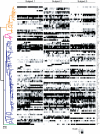Long-term temporal analysis of the human fecal microbiota revealed a stable core of dominant bacterial species
- PMID: 23874976
- PMCID: PMC3712949
- DOI: 10.1371/journal.pone.0069621
Long-term temporal analysis of the human fecal microbiota revealed a stable core of dominant bacterial species
Abstract
Next-generation sequencing has greatly contributed to an improved ecological understanding of the human gut microbiota. Nevertheless, questions remain regarding the characteristics of this ecosystem and the ecological processes that shape it, and controversy has arisen regarding the stability of the bacterial populations and the existence of a temporal core. In this study, we have characterized the fecal microbial communities of three human individuals over a one-year period by 454 pyrosequencing of 16S rRNA tags in order to investigate the temporal characteristics of the bacterial communities. The findings revealed a temporal core of 33 to 40 species-level Operational Taxonomic Units (OTUs) within subjects. Although these OTUs accounted only for around 12% of the total OTUs detected, they added up to >75% of the total sequences obtained for each individual. In order to determine the capacity of the sequencing and bioinformatic approaches applied during this study to accurately determine the proportion of a core microbiota, we analyzed the fecal microbiota of nine mice with a defined three-member community. This experiment revealed that the sequencing approach inflated the amount of rare OTUs, which introduced a significant degree of artificial variation across samples, and hence reduced the apparent fraction of shared OTUs. However, when assessing the data quantitatively by focusing on dominant lineages, the sequencing approaches deliver an accurate representation of the community. In conclusion, this study revealed that the human fecal microbiota is dominated by around 40 species that maintain persistent populations over the duration of one year. The findings allow conclusions about the ecological factors that shape the community and support the concept of a homeostatic ecosystem controlled largely by deterministic processes. Our analysis of a three-member community revealed that methodological artifacts of OTU-based approaches complicate core calculations, and these limitations have to be considered in the interpretation of microbiome studies.
Conflict of interest statement
Figures



References
MeSH terms
Substances
LinkOut - more resources
Full Text Sources
Other Literature Sources
Medical
Molecular Biology Databases

